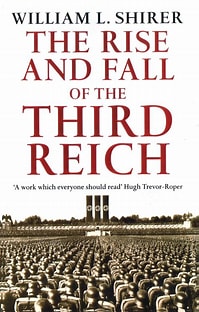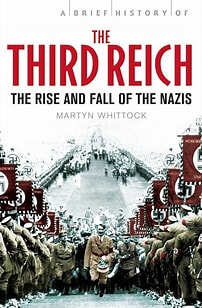The Rise and Fall of the Third Reich
Introduction
The Third Reich, a term synonymous with Adolf Hitler’s regime, marked one of the darkest periods in modern history. Spanning from 1933 to 1945, it was characterized by aggressive expansionism, unprecedented atrocities, and ultimately, catastrophic defeat. In this comprehensive exploration, we’ll delve into the roots, rise, dominance, and eventual downfall of the Third Reich, uncovering the intricate web of events and ideologies that shaped this era.
The Genesis of the Third Reich
Early 20th Century Germany
The seeds of the Third Reich were sown in the fertile ground of post-World War I Germany. The Treaty of Versailles in 1919 left Germany humiliated and economically crippled. Amidst this backdrop of desperation and nationalistic fervor, Adolf Hitler and his Nazi Party found fertile soil for their radical ideology.

Hitler’s Ascent to Power
Adolf Hitler, an Austrian by birth, was a charismatic orator who tapped into the collective discontent of the German populace. His promises of economic revival, national restoration, and retribution against perceived enemies resonated deeply. By 1933, Hitler had maneuvered his way into the position of Chancellor, effectively marking the beginning of the Third Reich.
The Consolidation of Power
The Reichstag Fire
In February 1933, the Reichstag fire provided a convenient pretext for Hitler to enact emergency powers. Blaming communists for the arson, Hitler convinced President Hindenburg to sign the Reichstag Fire Decree, which suspended civil liberties and enabled the suppression of political opposition.
The Enabling Act
The Enabling Act of March 1933 further cemented Hitler’s grip on power. This legislation allowed him to enact laws without the Reichstag’s consent, effectively rendering the German Parliament obsolete. The stage was set for a totalitarian regime.
Purge of the SA
In 1934, the Night of the Long Knives saw the elimination of the SA’s leadership, consolidating Hitler’s control over the military and eliminating potential rivals within his own party. This act of ruthless consolidation marked a pivotal moment in Hitler’s unchecked rise to power.
The Ideological Underpinnings
Aryan Supremacy
At the core of Nazi ideology was the belief in Aryan supremacy. Hitler’s vision of a racially pure Germany led to the implementation of racially discriminatory laws and the marginalization of non-Aryan communities, particularly Jews.
Anti-Semitism
The Nuremberg Laws of 1935 institutionalized anti-Semitism, stripping Jews of their citizenship and basic rights. This ideological hatred set the stage for the horrors of the Holocaust, where six million Jews perished in concentration camps.
Lebensraum
The concept of Lebensraum, or “living space,” justified Germany’s territorial expansion. Hitler believed that the Aryan race needed more territory to thrive, leading to aggressive campaigns of conquest across Europe.

The Expansion of the Third Reich
Reoccupation of the Rhineland
In 1936, Hitler boldly reoccupied the Rhineland, violating the Treaty of Versailles. This move went unchallenged by France and Britain, emboldening Hitler’s expansionist ambitions.
Annexation of Austria
The Anschluss in 1938 saw the annexation of Austria into the Third Reich. This unification, achieved with minimal resistance, was portrayed as a triumph of pan-Germanism.
Munich Agreement and Czechoslovakia
The Munich Agreement of 1938 allowed Hitler to annex the Sudetenland, a region of Czechoslovakia with a significant German-speaking population. This appeasement by European powers only emboldened Hitler further.
Invasion of Poland
The invasion of Poland on September 1, 1939, marked the beginning of World War II. The swift and brutal blitzkrieg tactics overwhelmed Polish defenses, prompting Britain and France to declare war on Germany.
The Height of Nazi Power
Blitzkrieg and Early Victories
The early years of World War II saw Nazi Germany achieve stunning victories through its blitzkrieg strategy. Countries like Denmark, Norway, Belgium, and France fell in rapid succession, establishing German dominance over much of Europe.
The Battle of Britain
However, the Luftwaffe’s failure to gain air superiority in the Battle of Britain in 1940 marked a turning point. Britain’s resilience and the Royal Air Force’s determined defense thwarted Hitler’s plans for an invasion.
Operation Barbarossa
In 1941, Hitler launched Operation Barbarossa, the invasion of the Soviet Union. Initially successful, the campaign soon bogged down in the harsh Russian winter and fierce Soviet resistance, draining German resources and morale.
The Decline and Fall
The Turning Tide
By 1943, the tide of war began to turn against the Nazis. The defeat at Stalingrad and the subsequent Soviet counteroffensive marked the beginning of the end for the Third Reich.
Allied Invasion of Normandy
The Allied invasion of Normandy in June 1944 opened a new front in Western Europe. The successful D-Day landings marked a decisive blow to Nazi control and accelerated the liberation of occupied territories.
The Collapse of the Third Reich
As Allied forces closed in from the west and Soviet troops advanced from the east, the Third Reich crumbled. Hitler’s suicide on April 30, 1945, signaled the impending end. Germany officially surrendered on May 8, 1945, bringing World War II to a close.

The Aftermath
Nuremberg Trials
The Nuremberg Trials held Nazi war criminals accountable for their atrocities. These trials established a precedent for international justice and underscored the importance of holding perpetrators of genocide and war crimes to account.
Reconstruction of Germany
Post-war Germany was divided into occupation zones controlled by the Allied powers. The Marshall Plan played a crucial role in rebuilding the German economy and preventing the spread of communism in Western Europe.
Read This: Royal Regalia: A Timeless Tapestry of Power and Elegance
Conclusion
The rise and fall of the Third Reich serve as a stark reminder of the dangers of totalitarianism, unchecked ambition, and racial hatred. This period in history underscores the importance of vigilance, education, and commitment to human rights to prevent such atrocities from occurring again.
FAQs
1. What was the Third Reich?
The Third Reich refers to the period of Nazi rule in Germany from 1933 to 1945, led by Adolf Hitler.
2. What were the Nuremberg Laws?
The Nuremberg Laws were racially discriminatory laws enacted in 1935 that stripped Jews of their citizenship and basic rights.
3. What was Operation Barbarossa?
Operation Barbarossa was the code name for Nazi Germany’s invasion of the Soviet Union in 1941.
4. How did the Third Reich end?
The Third Reich ended with Germany’s surrender on May 8, 1945, following Hitler’s suicide and the Allied and Soviet advances into German territory.
5. What were the Nuremberg Trials?
The Nuremberg Trials were military tribunals held after World War II to prosecute Nazi war criminals for their involvement in war crimes and the Holocaust.
Meta Description
Dive deep into the history of the Third Reich, exploring its rise to power, ideological foundations, expansionist ambitions, and eventual downfall during World War II.


